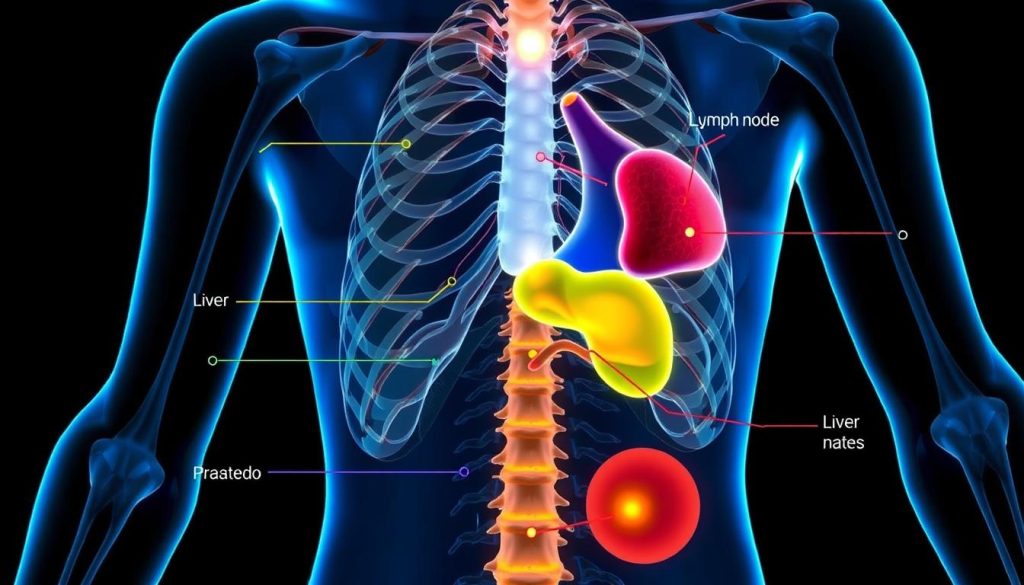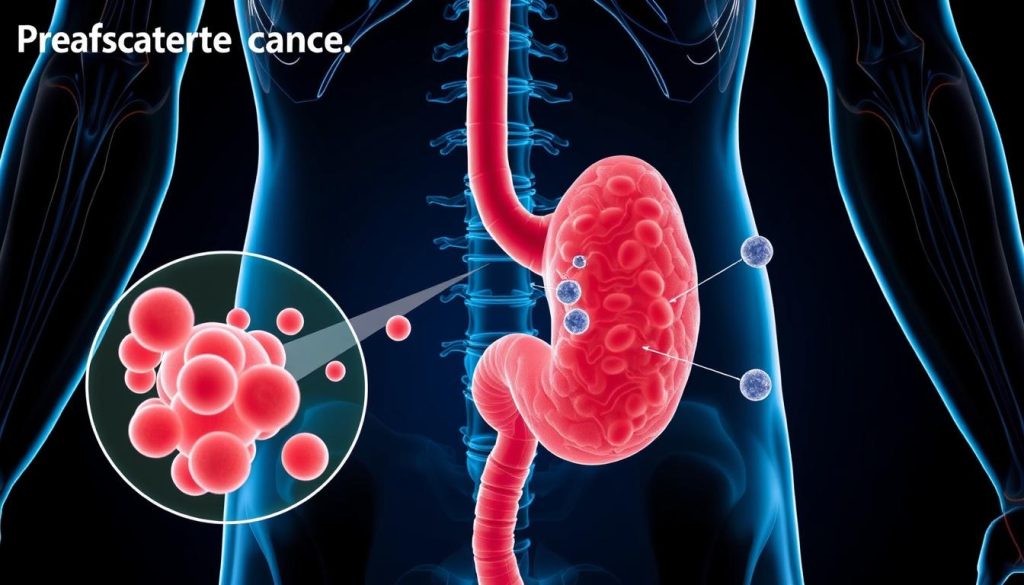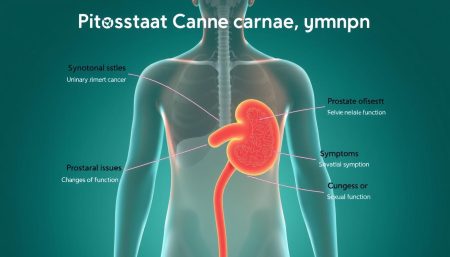Prostate cancer spread is a big worry for men with advanced disease. Knowing where prostate cancer spreads first is key for early treatment. Metastatic prostate cancer often follows certain patterns in the body.
This article looks at how prostate cancer cells move from the main tumor to other parts of the body. We’ll see where they usually go and how the lymphatic and blood systems help them. Understanding these patterns helps patients and doctors improve life quality for those with advanced prostate cancer.
Understanding Prostate Cancer and Its Spread Patterns
Prostate cancer can range from being localized to spreading widely. Knowing how it progresses is vital for treatment. Let’s look at how prostate cancer cells move through the body.
The Biology of Prostate Cancer Cells
Prostate cancer cells grow slowly at first but can become aggressive. They have proteins that help them survive and multiply. As they grow, they form a tumor in the prostate gland.
How Cancer Cells Break Away from the Primary Tumor
Prostate tumor metastasis starts when cancer cells break free. They use enzymes to dissolve tissue around them. This lets them enter blood vessels or lymph nodes. Once free, they can travel to other parts of the body.
Role of Lymphatic and Blood Systems in Cancer Spread
The lymphatic and blood systems are like highways for cancer cells. They provide paths for prostate cancer to spread. Cells in the bloodstream can reach distant organs. Those in the lymph system often go to nearby lymph nodes first.
| Spread Method | Primary Targets | Speed of Spread |
|---|---|---|
| Lymphatic System | Nearby lymph nodes | Slower |
| Bloodstream | Bones, liver, lungs | Faster |
Understanding these spread patterns helps doctors predict where prostate cancer might go. This knowledge is key for early detection and targeted treatment of metastatic disease.
Common Sites Where Does Prostate Cancer Metastasis
Prostate cancer’s spread is a big factor in its prognosis. Knowing where it usually goes is key for both patients and doctors. Common places include bones, lymph nodes, and major organs.

Bones are a favorite spot for prostate cancer cells. The spine, pelvis, and ribs are especially at risk. This affects treatment plans and how well a person can live.
Lymph nodes, especially in the pelvis, are often the first stop for cancer.
Other organs like the liver and lungs can also get cancer. Though rare, the brain can also be affected in late stages. Finding blood cancers early is crucial for better outcomes.
| Metastasis Site | Frequency | Impact on Prognosis |
|---|---|---|
| Bones | High | Significant |
| Lymph Nodes | Common | Moderate |
| Liver | Less Common | Severe |
| Lungs | Less Common | Severe |
| Brain | Rare | Very Severe |
Knowing these patterns helps doctors plan better treatments. Regular check-ups and talking openly with doctors are vital for managing prostate cancer.
Bone Metastases: The Primary Target in Prostate Cancer
Prostate cancer often spreads to bones, making bone metastases a key concern. Understanding why this happens and how to detect it is crucial for patients and doctors alike.
Why Prostate Cancer Favors Bone Tissue
Prostate cancer cells have a special attraction to bone. This is due to the rich environment bones provide, full of growth factors and nutrients. The interaction between cancer cells and bone tissue creates a cycle that fuels tumor growth.
Most Common Bone Sites Affected
Bone metastases in prostate cancer typically occur in specific areas:
- Spine
- Pelvis
- Ribs
- Long bones (arms and legs)
These sites are common because of their high blood flow and bone marrow content, which attract cancer cells.
Detecting Bone Metastases Through Imaging
Early detection of bone metastases is vital for effective treatment. Doctors use various imaging techniques to find and monitor these spread:
- Bone scans: Show areas of increased bone activity
- CT scans: Provide detailed cross-sectional images
- MRI: Offers high-resolution images of soft tissues and bones
- PET scans: Detect cancer activity in the entire body
These tests help doctors track the spread of prostate cancer to bones and plan appropriate treatments. Regular screenings are important for catching bone metastases early and improving patient outcomes.
Lymph Node Involvement and Metastatic Progression
Lymph node involvement often signals the beginning of prostate cancer spread. When cancer cells break free from the prostate, they can travel through the lymphatic system. This network of vessels and nodes acts like a highway for these rogue cells.

In advanced prostate cancer, lymph nodes near the prostate are usually the first to be affected. As the disease progresses, distant lymph nodes may also become involved. This progression can impact treatment decisions and overall prognosis.
“Lymph node metastases are a critical factor in determining the stage and treatment approach for prostate cancer patients.”
Detecting lymph node involvement is crucial for proper staging and treatment planning. Doctors use various techniques to identify affected nodes:
- CT scans
- MRI
- PET scans
- Sentinel lymph node biopsy
The presence of cancer in lymph nodes can influence treatment choices. Patients with node-positive disease may require more aggressive therapies to manage their advanced prostate cancer effectively.
| Lymph Node Status | Treatment Approach | Prognosis |
|---|---|---|
| Node-negative | Local therapy (surgery or radiation) | Generally favorable |
| Limited node involvement | Combined local and systemic therapy | Intermediate |
| Extensive node involvement | Systemic therapy (hormone therapy, chemotherapy) | Less favorable |
Ongoing research aims to improve detection and treatment of lymph node metastases in prostate cancer. New imaging techniques and targeted therapies offer hope for better outcomes in patients with node-positive disease.
Identifying Early Signs of Metastatic Spread
Spotting the early signs of metastatic prostate cancer is key to better treatment and outcomes. Keeping an eye on symptoms and getting regular check-ups can help find cancer spread early.
Physical Symptoms and Warning Signs
Men with metastatic prostate cancer might feel bone pain, especially in the spine, hips, or ribs. They might also lose weight without trying, feel very tired, or have trouble peeing. It’s important to tell a doctor about any strange feelings right away.
PSA Levels as Indicators of Metastasis
PSA levels are important for watching how prostate cancer grows. A quick jump in PSA levels after treatment could mean the cancer has spread. Regular PSA tests help track changes and decide what to do next.
Diagnostic Tools and Screening Methods
There are many ways to find metastatic prostate cancer. Bone scans, CT scans, and MRIs can show where the cancer has gone. Blood tests can find cancer cells in the blood. These tools, along with physical exams and PSA tests, help figure out how far the cancer has spread and what treatment to use.
| Diagnostic Tool | Purpose | Detection Capability |
|---|---|---|
| Bone Scan | Identify bone metastases | High sensitivity for bone lesions |
| CT Scan | Detect lymph node involvement | Effective for soft tissue metastases |
| MRI | Detailed imaging of organs | Precise for local and distant spread |
| PSA Test | Monitor cancer activity | Indicates potential progression |
Treatment Strategies for Metastatic Disease
When prostate cancer spreads, doctors use many treatments to fight it. Hormone therapy is often the first choice. It lowers testosterone levels, which can slow cancer growth. For some men, this treatment can keep the cancer in check for years.
Chemotherapy is another important treatment for metastatic prostate cancer. It uses drugs to kill cancer cells all over the body. While it can be tough, newer drugs have fewer side effects. Some men may also benefit from immunotherapy, which boosts the body’s defenses against cancer cells.
Targeted treatments are making a big difference in treating metastatic prostate cancer. These drugs focus on specific features of cancer cells, with less harm to healthy cells. Doctors may use different treatments together for the best results. Each man’s cancer is unique, so treatment plans are made just for him.
Research is always looking for new ways to tackle metastatic prostate cancer. Clinical trials offer hope for better outcomes, testing new drugs and combinations. The goal is to extend life while keeping quality of life good. With advances in medicine, men with advanced prostate cancer have more options than ever before.
FAQ
Q: Where does prostate cancer typically metastasize first?
A: Prostate cancer usually spreads first to the bones and lymph nodes. The bones, especially in the spine, pelvis, and ribs, are the most common sites. Lymph nodes in the pelvic and abdominal areas often get involved early.
Q: How do prostate cancer cells spread to other parts of the body?
A: Cancer cells spread through the lymphatic system and bloodstream. They break away from the main tumor and travel to other parts of the body. This process is complex, allowing cells to survive and grow in new places.
Q: What are the early signs of metastatic prostate cancer?
A: Early signs include bone pain, especially in the back, hips, or pelvis. You might also experience unexplained weight loss, fatigue, and urinary problems. A rising PSA level after treatment is another indicator. Always tell your doctor about any unusual symptoms.
Q: How is metastatic prostate cancer diagnosed?
A: Doctors use blood tests, imaging studies like bone scans and MRIs, and sometimes biopsies to diagnose metastatic prostate cancer. They also consider your symptoms and medical history.
Q: Why does prostate cancer often spread to the bones?
A: Prostate cancer likes bone tissue for several reasons. The bone environment supports cancer cell growth. Cancer cells also interact with bone cells, creating a cycle that promotes both cancer and bone destruction.
Q: What treatment options are available for metastatic prostate cancer?
A: Treatments include hormone therapy, chemotherapy, immunotherapy, targeted therapies, and radiation therapy. The right treatment depends on the cancer’s spread, previous treatments, and your health. Often, a mix of therapies is used.
Q: Can metastatic prostate cancer be cured?
A: Metastatic prostate cancer is not usually curable, but many patients live for years with it. Thanks to advanced treatments, survival rates and quality of life have improved. The goal is to control the cancer and manage symptoms.
Q: How does lymph node involvement affect prostate cancer prognosis?
A: Lymph node involvement means the cancer is more advanced. But, with modern treatments, many patients do well. The extent of lymph node involvement, along with PSA levels and Gleason score, helps determine the prognosis and treatment plan.


















